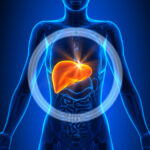Liver Disease in CF Appears Linked to Problems in CFTR Protein

A unique interaction between CFTR — the protein defective in people with cystic fibrosis (CF) — and two pro-inflammatory proteins may explain why some CF patients develop liver disease, researchers reported.
Their work suggests that the CFTR protein can act as an anchor, bringing certain proteins — including the pro-inflammatory beta-catenin and the p65 subunit of NF kappa B — together to prevent their activation.
When CFTR is missing or dysfunctional, these proteins are activated, which can lead to the overgrowth of cells lining the bile ducts — called biliary epithelial cells or BECs — and cause liver inflammation. (Bile ducts are thin tubes that go from the liver to the small intestine.)
“This missing interaction is at the core of the pro-inflammatory environment in the fibrotic liver — it adds insult to injury and makes the disease worse,” Satdarshan (Paul) Monga, MD, a professor of pathology and medicine at the University of Pittsburgh and the study’s senior author, said in a university press release.
Findings were reported in the study “β-Catenin-1 NFκB-CFTR interactions in cholangiocytes regulate inflammation and fibrosis during ductular reaction” published in the journal eLife.
Why liver disease affects some CF patients is not well understood. A team led by researchers at the University of Pittsburgh investigated this, looking at how the expansion of biliary epithelial cells, an important repair process following liver injury or disease, is associated with inflammation and fibrosis.
Researchers created two different mouse models using genetic tools. The KO1 model had beta-catenin loss in both hepatocytes (the main functional liver cells) and in BECs (also known as cholangiocytes). The KO2 model had loss of beta-catenin only in hepatocytes.
Beta-catenin is well known to play a key role in hepatocyte proliferation, allowing for liver repair with injury or disease.
Mice in both models were exposed for two weeks to a special diet (choline-deficient, ethionine-supplemented diet) that induces liver injury. They were then allowed to recover on a normal diet, and assessed two weeks, three months, and six months later.
In both models, researchers saw a greater degree of cell death, inflammation, and fibrosis than was evident in wild-type (normal) mice. However, the two models seemed to show different recovery profiles.
Two weeks after switching to normal diet, KO1 mice continued to show greater injury due to problems with hepatocyte proliferation. Even six months later, KO1 mice had evidence of progressive ductular reaction — a proliferation of reactive bile ducts induced by liver injury — which is associated with inflammation and fibrosis. This suggested a morphology close to that seen in CF patients.
Analysis of beta-catenin levels and the expression (activity) of Ctnnb1, the gene which encodes beta-catenin, showed an absence of beta-catenin at the six-month assessment in KO1 mice. In contrast, in wild-type mice also given the injury-inducing diet, beta-catenin was detected and fibrosis seemed to resolve after two weeks on a normal diet.
Better repair with time was also evident in KO2 mice after moving to a regular diet. By six months, fibrosis seemed to have resolved in this model and Ctnnb1 expression was comparable to that of wild-type mice. Ductular reaction had also resolved in KO2 mice at six months, although not at three months.
“We observed highly divergent injury-repair responses in the two models. KO2 mice showed progressive repair through expansion of BEC-derived beta-catenin-positive hepatocytes, and resolution of inflammation, [ductular reaction] and fibrosis,” the researchers wrote.
Beta-catenin’s lack in the BECs of the KO1 model was thought to cause sustained activation of the NF kappa B protein — a crucial regulator of immune and inflammatory responses — upon injury, leading to greater inflammation. NF kappa B is activated through the interaction of the beta-catenin protein with p65 (a subunit of NF kappa B).
In contrast, in KO2 mice that lacked hepatocytes but not beta-catenin, the beta-catenin–p65 complex was able to be re-established, “thus preventing chronic [NF kappa B] activation,” the researchers wrote.
“KO2 show gradual liver repopulation with BEC-derived b-catenin-positive hepatocytes, and resolution of injury,” they noted, which mice in the KO1 model did not.
Researchers next worked with liver tissue samples from multiple sources, including CF patients, to determine if the interactions seen in mouse models and cell studies could be replicated. Specifically, they were looking for how p65 and beta-catenin may be interacting with the CFTR protein.
Turning off, or stopping, expression of the CFTR gene so that no CFTR protein is produced led to a pronounced activation of p65, the researchers found. Liver tissue from a CF patient was also seen to have lower-than-usual levels of total beta-catenin.
“Doing an experiment and confirming for the first time that what we saw in mice was also what we see in patients with cystic fibrosis was very exciting and validating,” said Shikai Hu, the study’s first author.
Based on these results, the team suggested that the CFTR protein acts as a molecular anchor, interacting with beta-catenin-1 and p65 to prevent their activation. When CFTR is absent or defective, as in CF, these proteins become activated and ultimately induce progressive liver inflammation and fibrosis.
“We report a novel beta-catenin-NF kappa B-CFTR interactome in BECs, and its disruption may contribute to hepatic pathology [liver disease] of CF,” the researchers concluded.
More studies are need, they added, to further understand the molecular changes caused by CF in the liver.







